Menus
- Crossover motorcycles in comparison test
- Cruise control, throttle response, transmission
- Straight-line stability, performance, wind protection
- Handling, chassis, engine
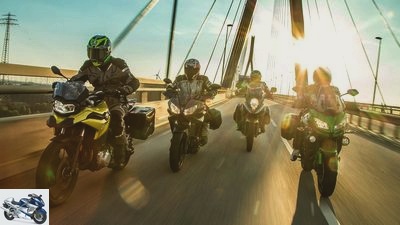
Arturo Rivas
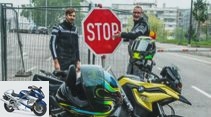
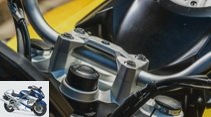
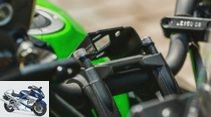
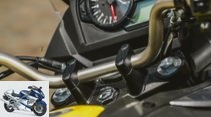
17th photos
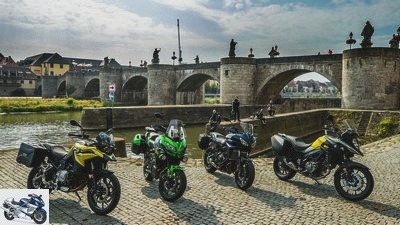
Arturo Rivas
1/17
Wurzburg’s old Main Bridge, completed in 1703, an imposing landmark of the city.
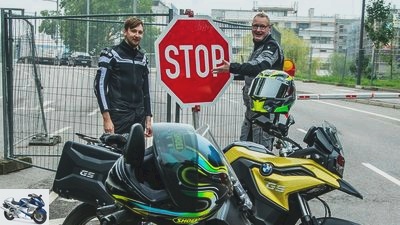
Arturo Rivas
2/17
Behind it is the Bleach Island Bridge in Heilbronn. Unequaled for us.
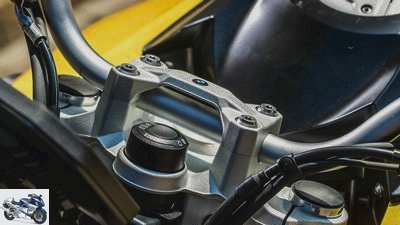
Arturo Rivas
3/17
With the BMW, the handlebar is in front of the fork legs.
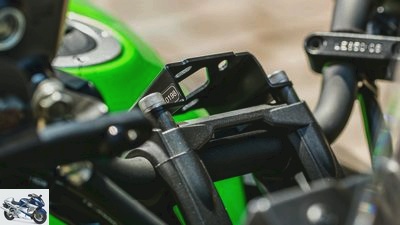
Arturo Rivas
4/17
The Kawasaki has the longest risers.
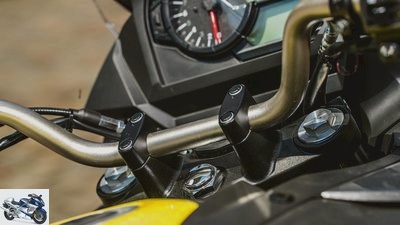
Arturo Rivas
5/17
The Suzuki emphasizes function.
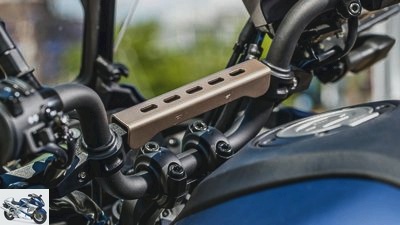
Arturo Rivas
6/17
The Yamaha cross brace offers space for an optional handlebar bag.

Arturo Rivas
7/17
The L 755 runs under the Altenbekener railway viaduct, and the trains roll along at the top.
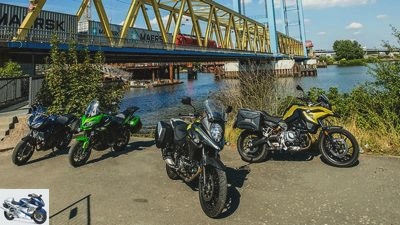
Arturo Rivas
8/17
The Kattwyk Bridge in the Port of Hamburg, Germany’s largest lift bridge. The big pots happen here every two hours.
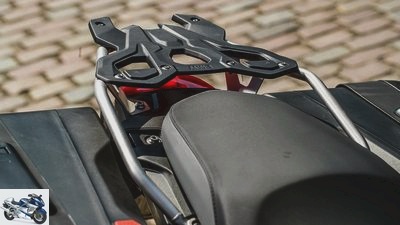
Arturo Rivas
9/17
The luggage rack is standard on the BMW.
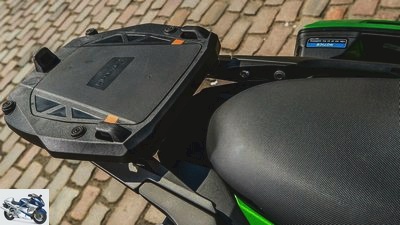
Arturo Rivas
10/17
The luggage rack is part of the Grand Tourer equipment on the Kawaski.
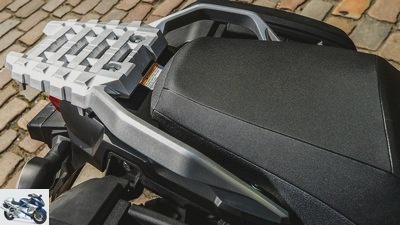
Arturo Rivas
11/17
The luggage rack is standard on the Suzuki.
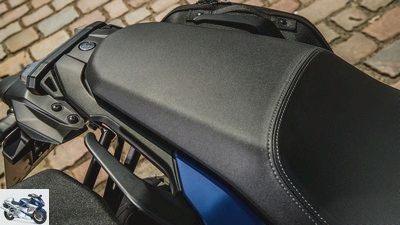
Arturo Rivas
12/17
Yamaha does without a luggage rack. So the short stern is in contradiction to the idea of travel.

Arturo Rivas
13/17
In flight over the Oberhafenbrucke in the Hanseatic city. Road traffic rolls below, rail traffic above.

Arturo Rivas
14/17
Who do the two pretty ones have in their selfie visor? The drivers (nope …), the motorcycles (maybe …), the picturesque moated castle in Hamburg’s Speicherstadt (of course!).
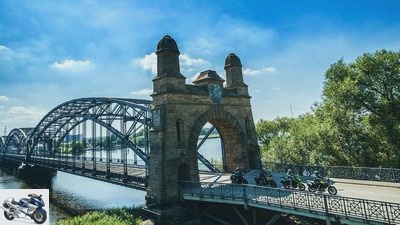
Arturo Rivas
15/17
Entry to Hamburg: through the majestic gates of the old Harburg Elbbrucke towards the city.
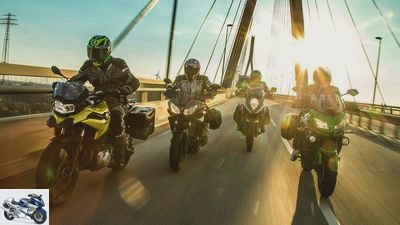
Arturo Rivas
16/17
The journey leads from Stuttgart in the north to Hamburg.
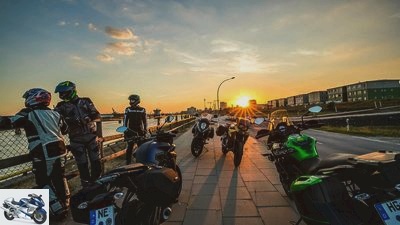
Arturo Rivas
17/17
The sun throws a final light on the Norderelbe and the cranes of Hafencity.
Versys 650, V-Strom 650, Tracer 700 and F 750 GS
Crossover motorcycles in comparison test
Crossover motorcycles such as the Kawasaki Versys 650, Suzuki V-Strom 650, Yamaha Tracer 700 and BMW F 750 GS pair the enduro look with sports touring genes. We tested the 4.
Crossover means the mix of styles. Under two-wheelers, the upright enduro look means a lot of game overview, supplemented by sports tourism aspects and 17-inch rims, because the next adventure is on the road. Strictly speaking, BMW’s new F 750 GS and Suzuki’s V-Strom 650 don’t fit into this grid. A 19-inch device rotates at the front. In both cases, however, its pure road profile clearly points in one direction, which does not allow for rough terrain. So everything is fine with the newcomer from Bavaria and the evergreen from Hamamatsu in this circle, which also includes Kawasaki’s Versys 650 and Yamahas Tracer 700 fellows.
Buy complete article
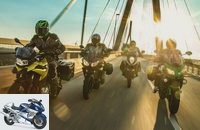
Versys 650, V-Strom 650, Tracer 700 and F 750 GS
Crossover motorcycles in comparison test
Sitting position, space, comfort
The BMW F 750 GS welcomes its rider. Slightly leaning forward dynamically, the hands grip the broad handlebars, the low-lying notches relax the knee angle. The comfort of the 830 millimeter high chair fits. This also applies to the Kawasaki Versys 650. Its handlebars stretch a little more towards the rider on long risers, but padding, knee angles and space are just as easy for collecting kilometers. Do you need more space? The Suzuki V-Strom 650 has it on offer. Your knee angle forces your legs into a more sporty basic posture because of the higher notches, but the rest is right under all respects. Tight knees, cozy but firm padding, upright seat: where do you go to the end of the world? And then it tweaks beforehand, the rump calls in. The straight sitting position behind the large tank is to blame. Together with the handlebars, which curve far back, the Suzuki driver sits comfortably but inactive in it. The great amount of weight on the buttocks cannot bed the best cushion like a litter in the long run. It’s a shame, there would be more.
The Yamaha Tracer 700 is more active, but only for people up to 185 cm. The Tracer is stingy with space, offers comfort, but little space to slide back and forth to change your sitting posture. This is okay for normal people, but it is difficult for longer ones.
Cruise control, throttle response, transmission
Thanks to cruise control, which is part of the BMW touring package, the F 750 GS scurries to the next stop with a relaxed driver. The others do without the speed controller.
It’s amazing how smoothly the Suzuki hangs on the gas and swims casually in traffic even in high aisles. The Yamaha masters this on a similar level, the Kawasaki only roars powerfully at speeds between 2,000 and 3,000 tours, is tame, but a little unmotivated, sometimes jerks slightly when applying the gas. Loud and a little rough, BMW can do that too under these conditions. Your motor grinds and rattles fervently with the timing chain, and your drive sometimes twitches at speeds of around 2,000 revolutions. Two steps forward, one backward – that’s what it feels like. Then it is better to shift down a gear with a well-functioning blipper – included in the dynamic package.
Since the gears are already being discussed: All of them are reliable. The BMW scores with the automatic gearshift for upshifting and downshifting, and it also pampers you with a finely adjustable clutch. With the Versys 650, one finger is enough to disconnect the frictional connection, the pressure point is good, but the switch box requires a strong foot. V-Strom 650 and Tracer 700 are just as impeccable overall, offering a high level of clutch and shift comfort.
Straight-line stability, performance, wind protection
On Autobahn 7, the focus is on straight-line stability. The BMW and Yamaha swiftly swept up the BAB driveway. With 78 and 75 hp, their engines set the tone in this field. Versys 650 and V-Strom 650 are content with 69 horsepower. Since all four are equipped with suitcases, the travel speed levels off at the recommended 130 km / h. Just a little sprint now and then spices up the stage.
Immovable, the BMW and the Suzuki suck meters under their wheels. With wheelbases of more than 150 cm, they run ahead without commuting. Deliberately initiated suggestions via the handlebars quickly fade away. The wheelbases of Kawasaki and Yamaha show what they want: to scurry, not to run straight ahead. 1,415 millimeters separate the front and rear wheels on the Kawasaki, 1,450 mm on the Yamaha. In addition, the undercarriages of both are comfortably tuned and have few reserves. If you want to, you get a lot of movement in both of them. So it’s better to go on comfortably. The wind protection behind the height-adjustable windows is consistently good for the Japanese at motorway speeds. It’s a bit turbulent behind the Suzuki windshield, depending on the size of the driver – it’s definitely better than on the BMW. Their micro-disks do not relieve the strain. The only thing that helps is crouching.
Handling, chassis, engine
Two hours later the pictures are in the box, the photographer hisses on towards the hotel in Paderborn. The rest of the way follows the L 755 out of Altenbeken. Finally curves. As if by themselves, Versys and Tracer find the tight line, scurrying effortlessly around the great bends in the route. The F 750 GS and V-Strom 650 demand clearer impulses. The wheelbases make themselves felt again. They are not as handy as Kawasaki and Yamaha. But their big hour is yet to come. The chassis of the BMW and the Suzuki easily make up for the extra effort through stability, precision and the successful chassis settings. The Kawasaki and Yamaha spin easily when load or gear changes are pending. Close the tap and brake before the bend – both of them collapse slightly. The Yamaha also acknowledges fast downshifts with a stamping rear wheel. The Versys masters this with ease thanks to the slipper clutch. But it is also not really quiet when the focus is on curvy driving pleasure. The switch to the Suzuki and the BMW immediately reveals this. The F 750 GS in particular drives much more confidently. The spring base of the semi-active, electrically adjustable dynamic ESA suspension is raised to the level of “person plus luggage”, the damping is adjusted to “dynamic” – and the BMW rushes through the angular work as if it were built up. The Suzuki can do that almost as well. Only her fork swings slightly after the braking phase. But it shines with the greatest freedom of inclination.
The good thing about it: Even under the aspect of comfort, the stable suspension settings of BMW and Suzuki do not mean any losses, both reach the level of the soft damping Kawasaki, the Yamaha even has to be clearly behind them. Despite its slightly gummy nature, it inspires time and again with its engine. It can really do everything, a great unit, just like the V2 of the Suzuki. If necessary, it turns fluffy upwards, where the BMW two slowly runs out of breath. At medium engine speeds, the Kawasaki twin signals: This is my home. Only: it spices up every revving over 5,000 tours with increasing vibrations. An electric eel that is easy to turn. After all, the Versys’ responsiveness is impeccable in this area. So let the twin cheer again. The next bend is already in sight, but why is the VW Bulli up there in the field so strange? The local law enforcement officers want to earn money on motorcycle fun. Time for the hotel.
At 15 liters, the BMW has the smallest tank – there is a risk of ebb in the fuel tank after 357 kilometers, despite the low 4.2 liters consumption. When it comes to consumption, the four don’t give each other much, with a full 21 liter tank capacity, the Kawa marks the top of the range in terms of range and would theoretically only have to return to the petrol pump after 525 kilometers.
Related articles
-
Eight large touring motorcycles in a comparison test
Photo: 24 photos 1/24 BMW R 1200 GS Rallye, Moto Guzzi Stelvio 1200 8V, Triumph Tiger Explorer, KTM 990 Adventure, Kawasaki…
-
48 hp motorcycles in a comparison test
Bilski 71 photos Bilski 1/71 Seven 48 hp twins from the manufacturers Honda, Ducati, Suzuki, Harley-Davidson, Kawasaki and BMW were tested. Bilski 2/71…
-
Comparison test motorcycles 800 class
Rivas 56 pictures Rivas 1/56 Rivas 2/56 Ouch: The gear lever and main stand already hit the ground at medium inclines. Rivas 3/56 Practical: handwheel on …
-
Test motorcycles for beginners
Test motorcycles for beginners Jump start What an indescribable feeling of limitless freedom that comes with a driver’s license for free. Especially with…
-
Supersport motorcycles in comparison test on the racetrack
Bilski 34 photos Bilski 1/34 Track test super athlete. Bilski 2/34 … The fact that he chose the Suzuki for this high-speed posing speaks for its…
-
Comparison test: touring motorcycles
fact 39 pictures fact 1/39 But now to the tourer bikes. The entry-level is the BMW R 1200 RT, which despite its mediocre engine with high-quality equipment, …
-
Comparison test: touring motorcycles – part 2
fact 39 pictures fact 1/39 But now to the tourer bikes. The entry-level is the BMW R 1200 RT, which despite its mediocre engine with high-quality equipment, …
-
48 hp motorcycles (model year 2019) in a comparison test
46 photos Jorg Kunstle 1/46 Six motorcycles compete against each other in the 48 hp comparison test. The models Kawasaki Z 400, KTM 390…
-
Comparison test of naked bikes from Japan
Art 15 pictures Art 1/15 Art 2/15 Art 3/15 Art 4/15 Art 5/15 Art 6/15 Art 7/15 Art 8/15 Art 9/15 Art 10/15 …
-
Comparison test 750 superbikes
Comparison test of 750cc superbikes The latest rumor that Suzuki had built a divine bike with the super light GSX-R, Kawasaki’s brand new ZX-7R was a …